
|
The Tanker market
in 2004
|
|
Crude oil transport: a year of
records |
|
see also : The
transport of refined oil products
|
|
2003 was marked by a sharp
difference between the high freight rates of the first
and fourth quarters and a fairly significant drop
during the second and third quarters.
If 2004 was also characterised by an
endemic volatility of the markets, with signs of
relative weakness in the second and third quarters, the
short-lived dips never reached the lowest levels of the
preceding years. However, the record levels of rates
registered throughout the second half, with the
exception of the month of December, will remain in the
annals, even if one should moderate this excess
somewhat with a particularly unfavourable dollar / euro
exchange rate.
For more than 20 years and in
all categories of tankers, has one seen freight at such
levels with daily returns surpassing $ 200,000 per day
for VLCC, flirting with $ 150,000 for the Suezmax and
exceeding the $ 100,000 level for the Aframax. At the
same time, crude oil prices broke the historic level of
$ 50 per barrel for a brief period.
Such exceptional results, which few
could have predicted with such a sustained strength,
require a detailed analysis permitting on one hand to
justify (or not) these record levels, and on the other
hand, to try to predict in the medium term a forecast
for a realistic evolution of our markets.
|
|
Objective
factors
World oil consumption has been
continuously rising for the past four years. Thus in
the fourth quarter of 2004 world demand reached 82.5
million barrels / day, its highest level for over 10
years. Forecasts by the International Energy Agency
predict a new probable increase in demand for 2005 of
700,000 barrels/day. OPEC production on its own is
nearly 30 million barrels/day, its highest level since
1990.
Some countries have registered
record increases in their demand. Compared to 2003,
China saw an increase of over 20% of its imports
(rising from 90 to nearly 120 million tons), with
Brazil nearly 15% and India 11%. By comparison, Europe
saw its needs increase by 6% and the U.S. by over 3%.
In the case of China and India, who
played a minor role in world oil traffic only a few
years ago, it is expected to see the rhythm of growth
being maintained, which, given the size of these
countries, will give them a preponderant position in
shipping terms in the coming years.
The other objective factor
explaining the steady rise of freight rates during the past
two years, has been the selective quality of chartered
tonnage. It has become more and more rigorous and the
progressive elimination of single-hulled tankers is now
a fairly standard generalisation. Parallel to this and,
as we shall see later, the situation of the shipyards
up until 2008 and the constantly rising price of newbuildings, justifies the attitude of owners and
explains their optimism for at least two to three years
to come.
|
|
Subjective
factors
Despite the various objective
elements which have just been cited, this certainly
does not justify the extent of the freight increases
which we have witnessed during the second half of 2004.
Some purely psychological factors,
even speculative, can only explain the mad rising
spiral which we have seen.
A fear of insufficient raw material
helped foster the speculative increase in oil prices,
and this psychosis pushed the level above $ 50 per
barrel. Some even forecast a price of over $ 60 per
barrel in the coming months.
While it is true that there is a
problem of availability of sweet crude in the longer
term, world proven reserves remain healthy and do not
in any way justify the pronounced fears.
To illustrate this, the announced
drop in American stocks, which largely contributed to
the rise in crude prices, was only a very short term
phenomenon. After the announcement at the beginning of
December of much less alarming figures, oil prices
rapidly plunged and went below $ 40 per barrel in less
than a week. However OPEC's decision to reduce its
production quota by 1 million barrels/day, has meant
that at the end of December crude prices were up around
$ 45 per barrel.
If numerous psychological factors
have had a significant impact in these last months, one
in particular seems important to us: the increasingly
important part played in the market by
"derivatives", in connection with both the oil
and shipping markets. Particularly speculative, this
market has certainly had an unforeseen effect not only
on crude prices but also on freight levels.
After this general introduction, we
shall try, as we do each year, to analyse each sector
by type of tanker to enable us then to give a realistic
synopsis of the past year and try to draw some
conclusions and predictions for the short and medium
terms.
|
|
VLCC
This sector of the fleet undeniably
remains the driving force today in the freight market.
If we revert to the forecasts for growth and production
over the coming years, we note the following main
elements: in 2010 the share of production from the
Arab-Persian Gulf will be about 42 million barrels per
day or 47% of the estimated world production of around
89.3 million barrels per day. In 2020 the world
production will be 107.3 million barrels per day and it
is estimated that the Gulf countries will contribute
around 58 million barrels per day. It is calculated
that such a figure will require the presence of 27 VLCC
per day to cover these exports, equal to an increase in
the fleet of nearly 170 units in the next 16 years'
Even if these figures should be
taken with some caution, it is nonetheless indisputable
that the predominance of this geographical zone and
this size of ship is here to stay.
As tangible proof: there was a
montlhly average of 91 ships fixed out of the Gulf in
2002, this figure rose to nearly 120 in 2004 (+30 %).
At the same time the fleet only increased by 5 %. This
simple statistic explains already the strong surge in
the freight rates.
|
|
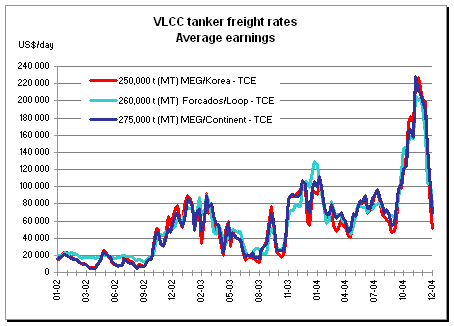
|
|
As we have already stated, the
increasingly preponderant share of exports to China and
India plays an essential role in the evolution of these
rates. One has seen in the last two years that the
ratio East/West of exports has gone from 70/30 to
about 75/25.
Parallel to this, one observes that
in this category of size the proportion of single-hulls
is the highest within crude tankers, namely some 40 %
of the current fleet in service (177 ships). With less
than 110 VLCC currently on order and a progressive and
inevitable elimination of older ships, owners have good
reasons to remain optimistic even if a large part of
single-hull ships now in service were built at the end
of the '80s or beginning of the '90s and still have a
number of years' trading left.
With the main traffic bound to
the East and Chinese and Indian owners up till now
being the principal takers of single-hulls, the
analysis of the evolution of freight rates is all the
more significant.
On the three main routes in our
graph, the average returns of a modern VLCC (on the
basis of a simple round-voyage) have not stopped
rising, going from $ 22,550 dollars per day in 2002 to
$ 52,500 in 2003 and over $ 95,000 in 2004.
Over the past 12 months, the minimum
return for a double-hulled VLCC was $ 41,000 per day in
April and the record was achieved in mid-November with
$ 228,000 per day.
In such a climate it is clear that
the number of tankers being sent for demilition was
low. At the same time few owners of modern ships were
willing to fix their ships on long term charters.
However on the basis of the few transactions concluded,
we can estimate a time-charter rate for one year at
about $ 80-85,000 per day, and at about $ 57,500 per
day on the basis of a three year charter.
|
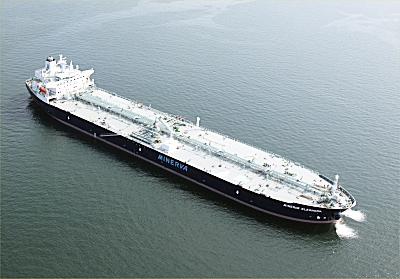
|
Minerva Eleonora
104,875 dwt, delivered in 2004 by Samsung HI, operated by Minerva Tankers |
|
|
Suezmax
Generally speaking, this category
experienced similar rate variations to those of VLCC,
which is hardly surprising given the direct influence
that one size has on the other.
As with VLCC, the average daily
returns have been constantly rising over the past three
years. On the basis of the two routes West Africa /
Gulf of Mexico and cross-Mediterranean, these have
moved from $ 20,500 per day in 2002 to $ 42,900 in 2003
and have slightly surpassed $ 70,000 in 2004.
|
|
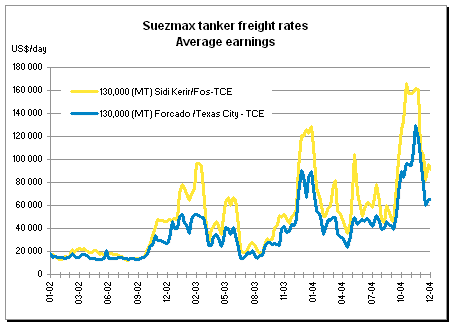
|
|
If the rate movements have often
been erratic, the returns have never been below $2
0,000 per day in 2004, the record being reached in
mid-November with over $ 160,000 per day for a
cross-Med movement.
Even though the voyages are short,
we can see yet again that the driving force is the
Mediterranean market and especially Russian exports out
of the Black Sea. It should also be observed that this
new improvement in freight rates has come about despite
exports of Iraqi crude from Ceyhan being particularly
weak and erratic following the successive sabotage of
the pipeline feeding the terminal.
Exports of Russian crude have not
stopped rising and the coming into service of the new
pipeline between the Caspian Sea and Ceyhan should help
reinforce the role of this zone as a
barometer of the Suezmax market.
Record delays of over 20 days during the winter of
2003 in order to transit the Turkish straits have not been repeated. Thanks to new navigational rules and milder
weather, round trip voyages have scarcely exceeded 10
days.
Despite an increasing share of
exports being taken by VLCC out of West Africa (always
with a proportion of 70/30 between East/West destinations), units of one million barrels
continue to find a stable market in this zone.
While Nigeria remains the main
exporting country, there has been significant and
confirmed export growth from other countries, notably
Angola, where deep sea drilling is being pursued at a
sustained rhythm, justifiable in view of the current
level of oil prices.
One has also seen a growing number
of fixtures out of the Arabian-Persian Gulf at record
freight rates this year, following the spectacular
highs set by VLCC. Thus on some spot business rates
have gone up to over Worldscale (WS) 400 for voyages to
China.
As with other sizes, the elimination
of old units has been particularly quick since for the
fleet in service at the end of the year, there are only
slightly over 20 % of single-hull ships.
Furthermore in line with the other
categories, few owners were inclined to place their
modern ships out on time charter, but rates can be
estimated between $ 55-60,000 per day on the basis of a
one year contract.
|
|
Aframax
This market has been particularly
boosted since the accidents of the 'Erika' and above
all the 'Prestige'. Security measures adopted by the
main players and the increase in trade movements has
allowed owners with renewed fleets to obtain freight
rates which give a rapid payback on their investment.
As an example and only on the
European market, if the average returns were only $
12,500 per day in 1999, they jumped to $ 40,000 in 2000
and then dropped to $ 21,500 in 2002, when the 'Prestige' accident
in November 2002 totally overturned the supply / demand
balance.
This European traffic has been in
continual growth since 2002, as between the
Mediterranean and the North Sea, the level has gone
from 45 % to 50 % of all spot charters done world-wide.
Despite a more marked volatility
compared to other sizes, the average daily returns have
moved up from $42,500 per day in 2003 to about $58,000
per day over the last 12 months.
Proof of the extreme volatility of
this market are the large variations in Mediterranean
demand which often put freight rates into a
roller-coaster movement, difficult to foresee
and to control, but with a strong upward pressure.
Returns on cross-Med voyages jumped from about $ 17,000
per day in April up to $ 110,000 per day at end
October!
|
|
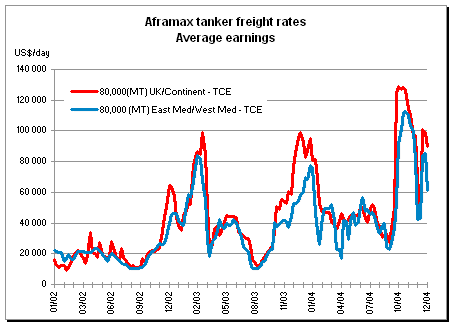
|
|
It should be noted that the record
levels reached at the end of the year were the result a
higher of demand, without any particular influence of
delays due to bad weather, such as experienced in 2003
with the transit of the Turkish straits.
As to the structure of the fleet,
today the proportion of modern double-hulled units is
predominent. The survival of some single-hulled ships
is limited to several Russian
traders out of the Black Sea, but their days are
numbered'
In the North Sea, freight variations
and returns closely followed the trends in the
Mediterranean with an average yearly rate working out
at WS 189 on the short cross-North Sea voyages. In
parallel there was also a strong progression of Russian
exports out of the Baltic and Murmansk. For such
voyages, even though ice-classed ships are now more
numerous, rates continued to be extremely high since
the beginning of the winter season (up to WS 440).
In the Caribbean market, with the
rise in American imports to help reconstitute
inventories,
we saw an increase in local movements and the average
annual rates were around WS 255 compared to WS 207 in
2003.
In such a situation, there were few
transactions given that the spot market enjoyed a steep rise. Nonetheless,
there are a number of owners who expect downward
pressure in the months to come, which would then be a
justification for some commitments to time charter
contracts.
|
|
Prospects
In face of the particularly erratic
fluctuations in rates, any
realistic prediction either for the medium or long term
is a highly precarious exercise. The slightest event of
either macro-economic or geopolitical nature will
continue to have an impact on the freight markets.
Nonetheless, as with our preceding
report, we consider that owners can reasonably expect
to see freight rates remaining firm over the next two
years. Even if on the economic front, various analyses
suggest that there will be lull in the growth for a
number of importing countries, the energy needs of
China and India alone will continue to have a
determining influence on the world tanker traffic.
It is however unlikely that we will
see in the next 12 to 24 months the exceptional levels
of freight rates experienced this year. We should
witness a steady decline in the average rates and reach
a level probably close to that of 2003, therefore still
considerably in favour of owners.
The arrival of new units into the
fleet is obviously a cause of concern, with such
imposing numbers as the table below indicates. On the
other hand we can expect that deletions will not be
sufficient to compensate for the number of new units. A
good number of Asian countries continue to use old single-hull ships and probably do not
respect the letter of the law as laid down by
international organisations.
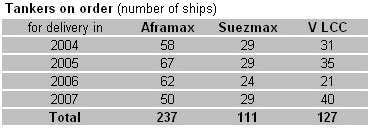
As we did in our previous report,
the study of the "eligible fleet" adds a clear
indication to the forecasts, and gives an initial
response which counterbalances the pessimism of
those who only look at the massive tonnage arriving on
the various markets.
|
|
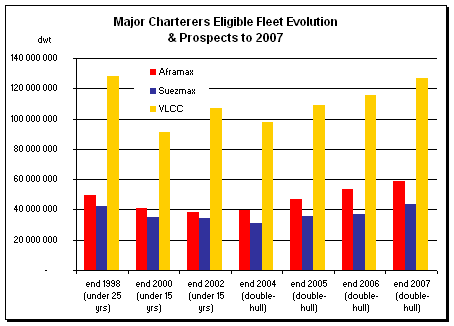
|
|
This time we only compare
the global tonnage at the end of 1998 (corresponding to
the main criteria used at this time by the main
charterers namely an age limit of 25 years) with what
will be the figures in the coming years but only taking
into account ships with double-hulls.
One observes that despite a constant
increase in tonnage in each of the categories, none of
the volumes surpasses the level achieved at the end of
1998.
The cost of new ships should
continue to rise, especially with the continuing
increase in the cost of raw materials from which they
are built.
The organisation between owners
leading to the creation of commercial pools should help
avoid sudden drops in the market and allow freight
rates to continue for a prolonged period at levels we
have seen recently.
Finally, the drastic safety measures
will continue to be reinforced and the balance between
supply and demand, which determines the rates, will be
more and more limited to the quality of ships
effectively meeting the requirements imposed by the
main charterers and not just by simple comparing supply
and demand figures.
|
Shipping and Shipbuilding Markets in 2004
I N D E X
|